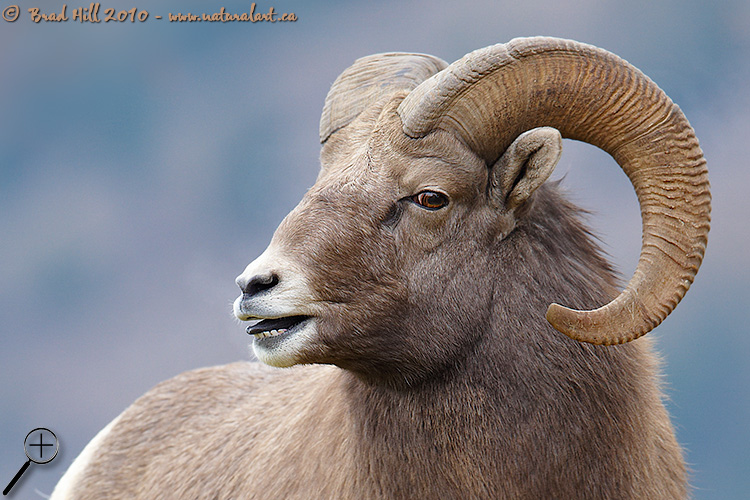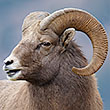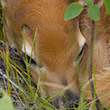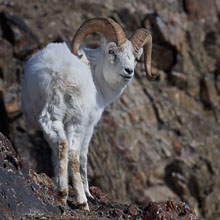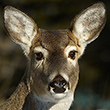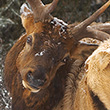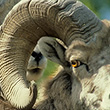Availability: Undetermined - Enquiries?
In the Field
Searching for Significance...Biologically. Radium, BC, Canada. November 11, 2008.
This is a portrait of a Bighorn ram that is in the midst of his search for biological significance - it's mating season and he's doing his best to ensure that some of his genes are still around after he's long gone. He's not sticking his tongue out at me (or his ram friends) - he just licked up a bit of urine from a female sheep and is in the middle of determining her state of estrous (during this tongue-out pose the ram is drawing air across the urine and using sensitive chemo-receptors to evaluate the breeding status of the female).
It's easy to think that wildlife portraits are simply about getting close to your subject. In reality, the task is MUCH more challenging than that. Not only must you get close to your subject, but you have to do it in the "right" light (defining "right" with light is dependent on what you what the image to convey, among other things). Of course, in a portrait you'll want to ensure you have the eye in focus, but...how much ELSE that's in focus (and intentionally OUT of focus) can make or break the image. And, with many organisms "other" aspects of the animal may be equally as important as the eye - in this case the curled horn almost defines the animal and it's a critical component of the image that also must be sharply rendered. And...then there's composition - it's critical that the eye and other critical anatomical features are carefully positioned in the frame. Finally, facial expressions and/or visually-expressed behavioural traits (like this horny ram sticking his tongue out), can also make or break the shot. And these are a just a FEW of the things to think about when creating wildlife portraits - after you get close!
So here you go - just a simple portrait of a Bighorn ram.
Behind the Camera
Searching for Significance...Biologically. Radium, BC, Canada. November 11, 2008.
Digital Capture; Compressed RAW (NEF) 14-bit format; ISO 720.
Nikon D3 with AF-S Nikkor 600mm f/4G IF-ED II VR lens supported on Gitzo 1348 carbon fibre tripod with Wimberley head. VR turned to "On" and in "Tripod" mode. Autofocus set to M/a mode.
1/125s @ f5.6; -0.33 stop compensation from matrix-metered exposure setting.
At the Computer
Searching for Significance...Biologically. Radium, BC, Canada. November 11, 2008.
RAW Conversion to 16-bit TIFF, including first-pass/capture sharpening, slight exposure adjustment, and white balance adjustment using Phase One's Capture One 4.
Further digital corrections on 16-bit TIFF file using Adobe's Photoshop CS4. Adjustments included selective colour saturation, selective curves adjustment and selective sharpening for web output.
Conservation
Searching for Significance...Biologically. Radium, BC, Canada. November 11, 2008.
Ten percent of the revenue generated by this image will be donated to Wildsight.
Species Status in Canada*: This species is not designated as at risk.
Bighorn Sheep (Ovis canadensis) are considered by many to be a symbol of mountain wilderness. They are distributed throughout much of the mountainous areas of western North America from central British Columbia south to northern Mexico. Local distribution of Bighorns appears to be limited by the availability of suitable foraging areas near "escape" terrain (cliffs or very steep terrain where they can escape predators).
This young Bighorn was photographed in the Columbia Valley of the East Kootenays. While this species is not currently considered at risk, many ecosystems within the Columbia Valley face development pressure, including pressure from logging operations. Wildsight is an effective conservation organization that protects biodiversity and promotes sustainable communities in Canada's Columbia and Rocky Mountains. Support for Wildsight, through donation or becoming a member, will help ensure that they remain effective in their efforts to conserve threatened or endangered species and ecosystems.
*as determined by COSEWIC: The Committee on the Status of Endangered Wildlife in Canada












